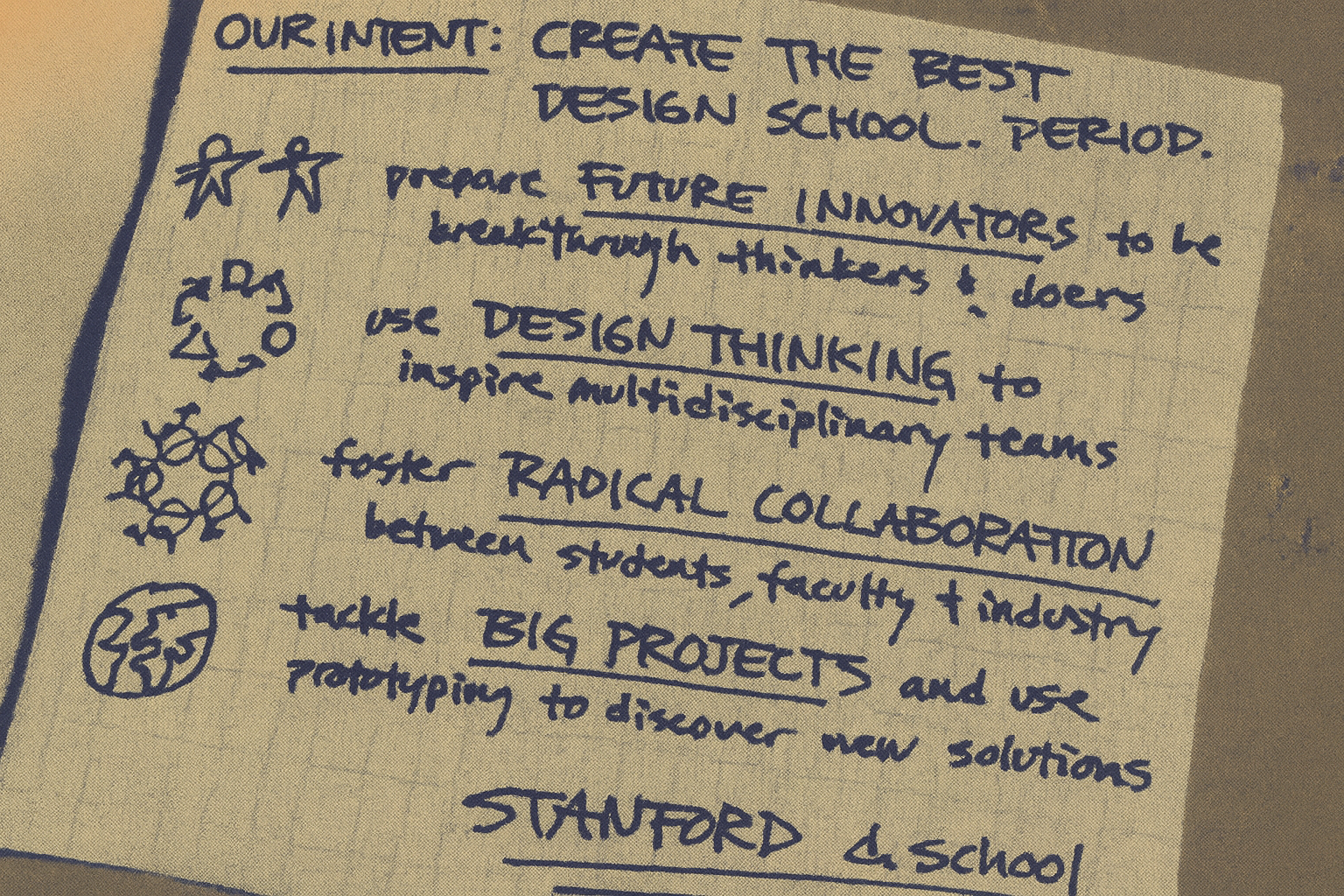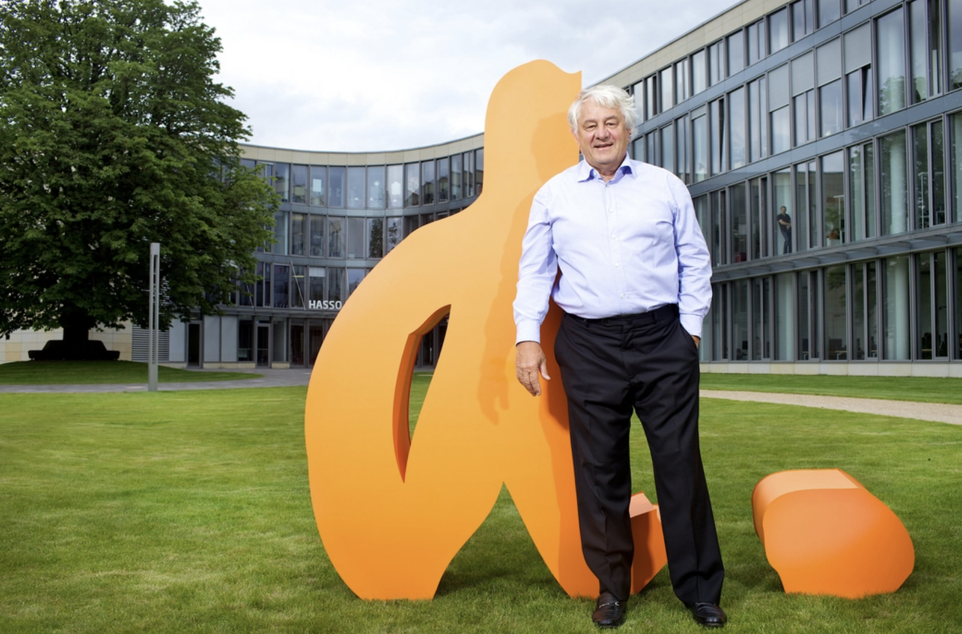Case Study FIFTEEN
David Kelley & Dr Hasso Plattner’s Design Thinking Capstone
The Stanford d.school
“We don’t need more know-how. We need more know-why.”
— Hasso Plattner
“The myth of the lone genius can get in the way of innovation. Great innovations come from teams, not from lone inventors.”
— David Kelley
~ Design isn’t just for designers ~
What began as a bold experiment at Stanford, chosen for its concentration of talent, ambition, and possibility, has evolved into a global Capstone with exponential impact. At its core lies a bigger idea: that creativity can be taught, and that those closest to the world’s toughest challenges can also be the ones to solve them.
CORNERSTONE
Two future design thinkers
David M. Kelley, born 1951 in Ohio, is the founder of the global design consultancy IDEO. He started his career not as a design guru but as an electrical engineer. It wasn’t until his work at Boeing and later as a product designer that he recognised the importance of empathy and user insight in innovation. In 1991, he co-founded IDEO, the design firm that would change how the world views creativity, designing everything from Apple’s first mouse to the defibrillator.
Meanwhile, Hasso Plattner, the systems conductor behind SAP, was scaling one of Europe’s largest tech companies. Trained in physics and engineering, Plattner always valued structured thinking—but came to believe that empathy was the missing piece in most product and policy failures. Born in 1944 in Berlin, Hasso co-founded SAP in 1972 and moved to Chairman of the Supervisory Board in 2003.
Both men, shaped by technical education, grew to challenge the idea that knowledge alone leads to innovation. They saw creativity as a skill to be taught, not an inborn trait.
We want to get as quickly as possible to the Capstone project they embarked on together, but here are some interesting facts along the way…
KEYSTONE
~ Hasso ~
When SAP went public in 1988, Hasso became Deputy Chairman of the Executive Board and later CEO (1997–2003). After retiring from day-to-day operations, he remained as Chairman and Chief Software Advisor. He champions the fusion of business, science, and innovation, supporting future-oriented research and entrepreneurial spirit.
~ David ~
In the early stages of David’s career, while working at Boeing, he was responsible for the design of the "occupied" sign that lights up when you lock the door on a 747.
He launched his own design firm in 1978 in Palo Alto—the same year he began teaching at Stanford. He earned tenure in 1990. In 1981, he designed the mouse for Apple’s radical new computer, the Lisa. His friend Steve Jobs repaid the favour by introducing David to his wife.
In 1991, his design firm DKD merged with others to become IDEO, where David served as CEO until 2000. His outlook was simple:
“I founded IDEO because I wanted to work in a creative environment surrounded by people I liked… I am most passionate about using design to help unlock creative confidence in everyone—from students to business executives.”
He also saw the power of business to drive real change:
“If the goal is to change the world, the business part changes the world faster.”
And he had a distinctive philosophy of leadership:
“My dream for the future of IDEO is the same as it was back then: that everyone at IDEO finds their calling, that being here feels like working with friends… that we are all engaged in what feels like important work we were personally put on Earth to do.”
In 2003, a conversation with then-IDEO CEO Tim Brown gave David clarity: Design Thinking. It wasn’t about people becoming designers, but about people thinking like design thinkers. He reframed his role:
“Now I’m an expert at methodology, rather than a guy who designs a new chair or car.”
He had mastered human-centred design, and realised it wasn’t just about how, it was about why:
“We, as design thinkers, have the creative confidence that, when given a problem, we have a methodology that enables us to come up with a solution that nobody has before.”
Teaching someone a method was transactional. Helping them transform their mindset was his true purpose.

CAPSTONE
~ The d. School ~
Unlike most academic institutions, the d.school doesn’t award degrees. Its mission is to infuse design thinking into other discipline, engineering, business, education, medicine, and law. Students learn by doing: radical collaboration, rapid prototyping, user-first research.
The ripple effect is by design. If Stanford were a company, its alumni and faculty would represent the world’s 10th-largest economy, responsible for over 40,000 companies, 5.4 million jobs, and $2.7 trillion in global revenue (figures from 2011).
Many of those ventures, from healthtech to fintech, were incubated at the d.school.
“I really do believe I was put on the planet to help people have creative confidence.” — David Kelley
For David, the how was design thinking. The why was creative confidence. But the what came when he convinced Hasso Plattner to back the idea.
In October 2005, with a $35 million donation from Hasso, the Hasso Plattner Institute of Design at Stanford was born. The d.school was co-founded by David, six other professors, and Silicon Valley entrepreneur George Kembel.
It empowered others with the same confidence and methodology IDEO gave its clients:
“Our dent in the universe doesn’t mean we have to do all the digging,” said David. “We empower our clients. We teach them to fish.”
The d.school’s mission is still in lockstep with David’s purpose:
“We believe everyone has the capacity to be creative. The Stanford d.school is a place where people use design to develop their own creative potential.”
IDEO now applies human-centred methodologies to challenges in government, healthcare, education, and beyond. Because:
“As long as you focus on the human, that is something everyone can get behind.” — David Kelley
In 2012, the d.school launched the Project Fellowship, inviting experts to tackle systemic change in their sectors.
“When I get depressed or worried about something, I often wander over to the d.school... I come away feeling good about life and about the things that Stanford students can create and invent.” — Jim Plummer, Dean of Stanford Engineering
The impact has gone global. HPI School of Design Thinking launched at the University of Potsdam in Germany, and d-school Afrika at the University of Cape Town.

MY EXPERIENCE WITH DAVID
John Maeda, former president of Rhode Island School of Design, said it best when I think of my interactions with David:
“He’s like a brainy Muppet. You want to hug him, stick by him, and support what he stands for.”
I was lucky enough to take David around the F1 paddock, garage and pit lane, and later went out with him and McLaren Group’s COO at the time Jonathan Neale. That dinner was unforgettable. David’s curiosity and logic lit up every conversation. I’ve never had such a mesmerising discussion.
It’s also a personal memory: after that dinner, I went to the F1 end-of-season party, feeling elated and inspired. I seized the moment, plucked up the courage to ask a girl I’d seen around the paddock out on a date. She’s now my wife.
Another reflection from one of David’s colleagues:
“From David, I’ve learned that there has to be someone to create something out of nothing. He embodies that. But he makes people feel he couldn’t have done it without them. Anybody who spends time with him comes away transformed.”
David once said many of his successful friends have two regrets:
They didn’t prioritise their children.
They did a job that looked good but felt bad, chosen for prestige or money, not purpose.
“I feel lucky I’m not in those two categories” he says.
MORE ON HASSO
In 1998, Hasso founded the Hasso Plattner Institute for Software Systems Engineering at the University of Potsdam and in Palo Alto. Funded entirely by his non-profit foundation, his contributions have exceeded €200 million.
He remains deeply involved as a lecturer and director, championing design thinking to address global problems:
“We must strive to improve our understanding of innovation processes in order to bring better solutions to society more quickly.”
“Design thinking reminded me of the good old days at SAP when we were closer to the customer.”
“From a global perspective, I wish design thinking would be used to tackle ecological problems or population growth. With design thinking, we can learn to embrace those questions together, across disciplines.”
In 2013, Hasso and his wife Sabine joined the Giving Pledge and later founded the Plattner Foundation, supporting health and education worldwide.
SUMMARY
We start with a quote from David that captures the essence of a Capstone:
“We talk about the importance of seeking out something meaningful to the people that you are trying to help. By getting that alignment it becomes a passion, it becomes a cause rather than something in your to do list. You got it. If you can get to that point, the problem is a cause for the people doing it. The key is getting everyone signed up to understand what is inspiring about what we are doing and then it kind of falls on place”.
And we close with how their legacy is being felt globally. As leading global technology services and consulting company, Cognizant, which employs over 350,000 people worldwide wrote:
“The embrace of the concept of ‘design thinking’ has changed the nature of technology development in recent years… With the prominence of Stanford University’s d.school, modern business systems and processes, for customers and employees, have reached new levels of ease of use, elegance and beauty.”
The d.school’s DNA, by design, runs through many changemakers- and changemaking ventures


